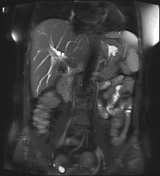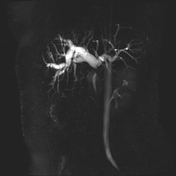Mirizzi syndrome
Updates to Study Attributes
The intrahepatic biliary ducts are moderately dilated (left hepatic duct > right hepatic duct).The gall bladder is hugely distended. A round signal void structure with a smooth border is seen in the neck of the gall bladder (measuring about 15 x 12mm). The structure is severely compressing and mildly displacing the common hepatic duct (CHD).
The common bile duct (CBD) is normal in calibercalibre and has homogeneous intraluminal signal intensity. Sludge is seen within the fundus and neck of the gall bladder.
Impression: large calculus at the neck of the gall bladder severely compressing the common hepatic duct and resulting in dilatation of intrahepatic biliary ducts - Mirizzi syndrome type I.
Image 5 MRI (T2 fat sat) ( update )

Image 6 MRI (MRCP-3D) ( update )

Updates to Case Attributes
Mirizzi syndrome is a rare condition which is caused by extrinsic compression over the extrahepatic biliary duct from stone within the cystic duct or gall bladder neck. It causes obstructive jaundice. Fistula can develop between gall bladder and common bile duct. Gall stoneGallstone ileus may also develop if the stone passes into small bowel through a cholecysto-enteric fistula.
Co-author- Dr. Shafayat Muhammed Shantonu (MD- hepatobiliary surgery)
-<p>Mirizzi syndrome is a rare condition which is caused by extrinsic compression over the extrahepatic biliary duct from stone within the cystic duct or gall bladder neck. It causes obstructive jaundice. Fistula can develop between gall bladder and common bile duct. Gall stone ileus may also develop if the stone passes into small bowel through a cholecysto-enteric fistula.</p><p></p><p><em>Co-author- Dr. Shafayat Muhammed Shantonu (MD- hepatobiliary surgery)</em></p><p></p><p></p>- +<p>Mirizzi syndrome is a rare condition which is caused by extrinsic compression over the extrahepatic biliary duct from stone within the cystic duct or gall bladder neck. It causes obstructive jaundice. Fistula can develop between gall bladder and common bile duct. Gallstone ileus may also develop if the stone passes into small bowel through a cholecysto-enteric fistula.</p><p></p><p><em>Co-author- Dr. Shafayat Muhammed Shantonu (MD- hepatobiliary surgery)</em></p>